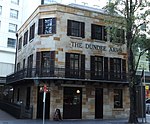Genesian Theatre
Amateur theatre companies in AustraliaTheatre in SydneyTheatres in Sydney

The Genesian Theatre is an amateur theatre company based in Sydney, Australia, named in honour of Saint Genesius, patron saint of actors. Formed in 1944 by members of the Sydney Catholic Youth Organisation, it has since evolved into a community theatre in the heart of the Sydney central business district.
Excerpt from the Wikipedia article Genesian Theatre (License: CC BY-SA 3.0, Authors, Images).Genesian Theatre
Kent Street, Sydney Sydney
Geographical coordinates (GPS) Address Nearby Places Show on map
Geographical coordinates (GPS)
| Latitude | Longitude |
|---|---|
| N -33.8720248 ° | E 151.2046834 ° |
Address
Kent Street 443-451
2000 Sydney, Sydney
New South Wales, Australia
Open on Google Maps










